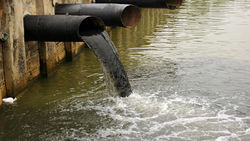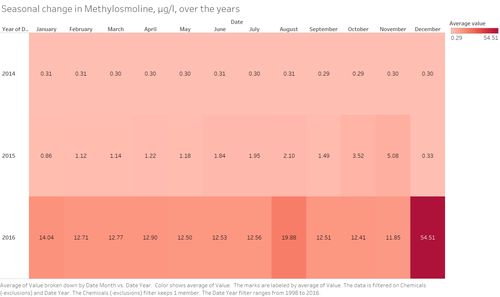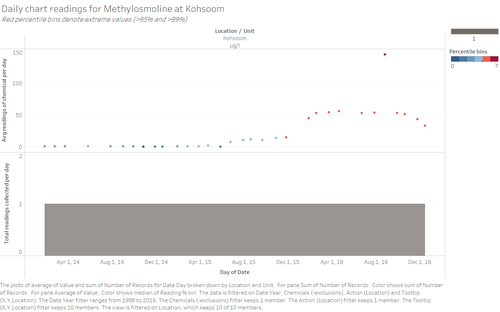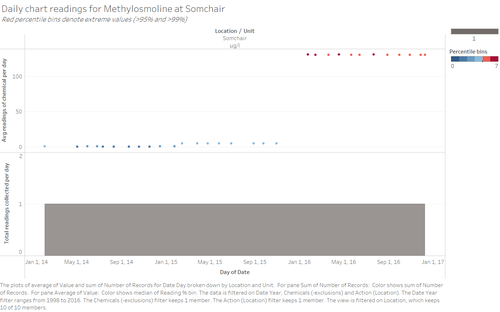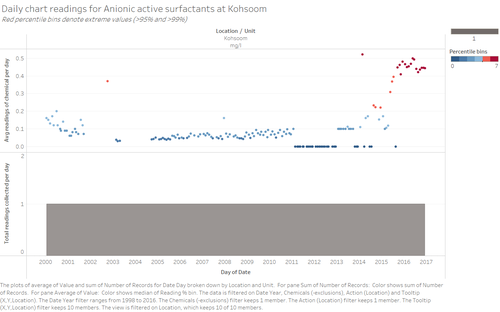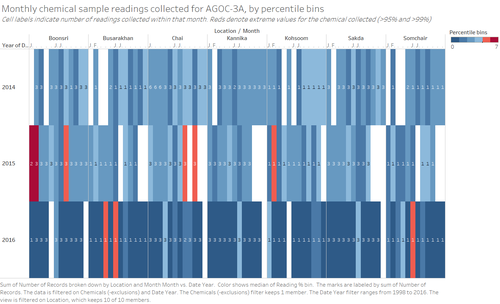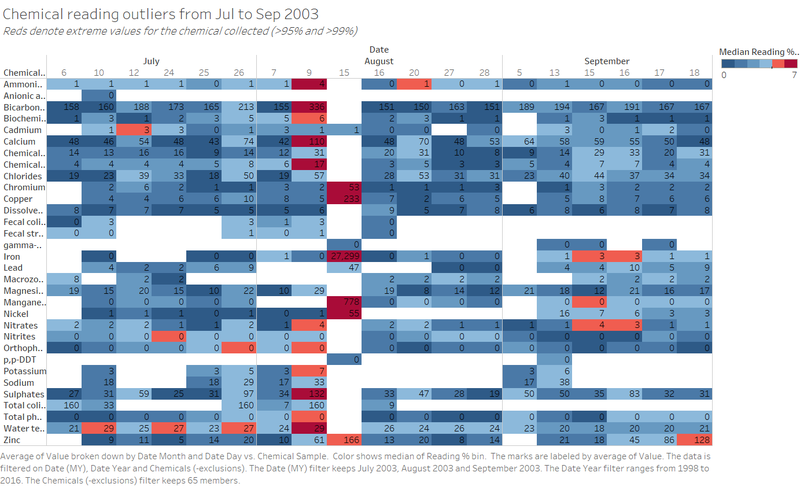ISSS608 2017-18 T3 Assign Low Zhi Wei Conclusion
Contents
Answering the important questions
Q1 - Trends of possible interest
A key finding on Methylosmoline indicates that its amounts have greatly increased in the whole of 2016. These are largely attributed to increases in Kohsoom and Somchair. This was shown in the 2 charts below:
Most concerning is the fact that the increases in Methylosmoline seem to be more greatly contributed by increases at Somchair as shown in the 2 charts below. It is situated significantly further from the site of alleged waste dumping, and does not share any waterways Kohsoom. This could possibly point to the existence of another dumping ground for Methylosmoline which is currently unknown.
From earlier analyses, it has already been noted that Kohsoom is a location of interest given its proximity to the alleged dumping grounds, and the commonality between multiple chemical reading outliers. The most significant of these would be the increases in Anionic active surfactants which show sustained increases which coincide with the increases of Methylosmoline. There is a case to investigate deeper on Kohsoom - on why it houses such abnormalities, as well as the relationship between Methylosmoline and Anionic active surfactants.
Lastly, it is important to continue monitoring of the AGOC-3A chemical which is touted by Kasios as a eco-friendly replacement to Methylosmoline, and to use the data for potential comparisons on other soil impacts. At this point in time, while data is few, it is worthwhile to note that concentrations of this chemical is low and have even dipped lower in 2016, coinciding with the increase in Methylosmoline that year.
Q2 - Data Anomalies and the Sampling Process
There were several anomalies noted in the data provided. Of these, a few significant ones to note would be:
- Data sparsity for Methylosmoline readings
- General data deficiencies across majority of chemicals
- The sudden and enormous increase of metals in readings for 15 August 2003
Data sparsity for Methylosmoline readings can already be noted from the earlier heat map, where there are multiple obvious gaps in measurement, which is crucial given it is the key chemical of interest for this exercise.
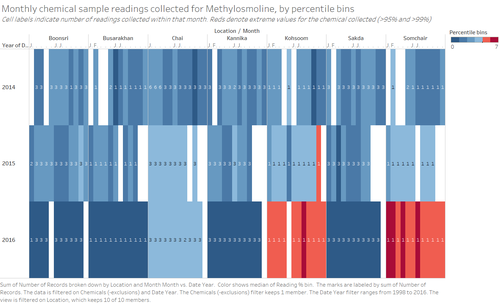
Data deficiency can be seen from visualising the total records collected with added perspective of breakdown by years. Also, most of the readings collected are only done one at a time, per day, instead of collecting a few to corroborate. These presents challenges in comparison of data values, as well as lowers the reliability of interpreting outliers.
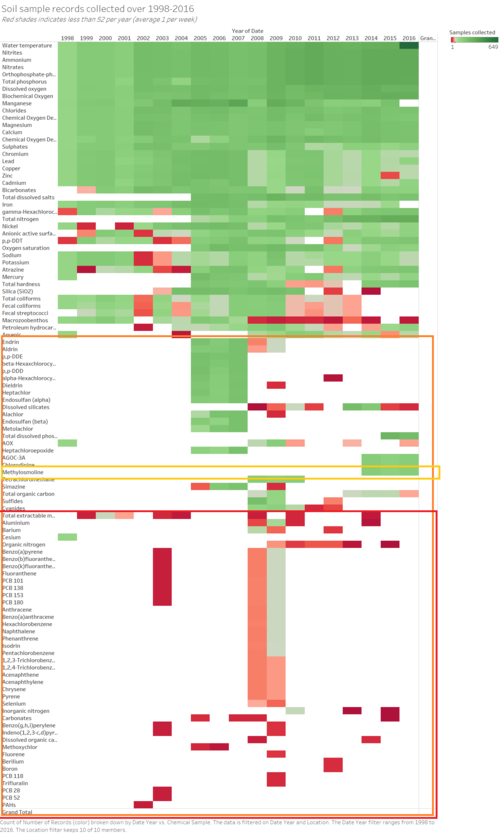
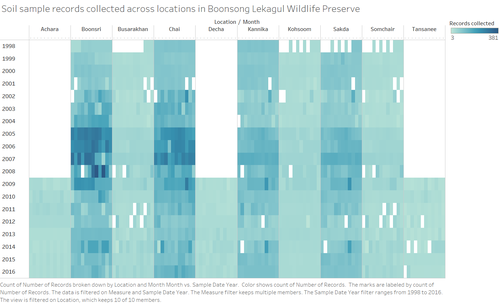
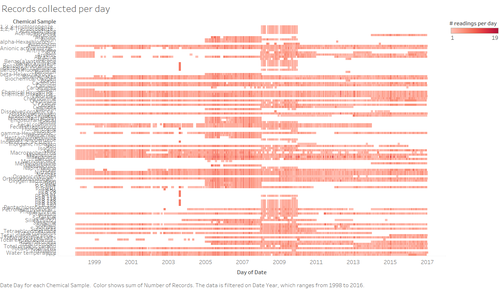
In addition, the data is not evenly collected across all locations as can be seen from the table below. The lack of consistency further hinders comparison efforts and understanding of trends.
| Location | No. of records |
|---|---|
| Achara | 2855 |
| Boonsri | 31314 |
| Busarakhan | 7492 |
| Chai | 31245 |
| Decha | 2731 |
| Kannika | 22152 |
| Kohsoom | 7895 |
| Sakda | 21429 |
| Somchair | 7537 |
| Tansanee | 2174 |
These data deficiencies lead to an incomplete and non-conclusive analysis on major patterns in the entire data, such as the single day increase in metals readings with no further residual impact.
Improving the Sampling Process
To address the data deficiency issues moving forward, the following measures can be implemented:
- Minimum number of chemical records at any one point of collection - For corroboration of values a useful benchmark could be 3 to 5.
- Regular frequency of collection - for practical reasons, daily intervals can be avoided. Instead, a bare minimum of weekly collections should be done.
- Consistent record-keeping - regardless of whether a chemical is detected, it should be recorded and assigned a value (zero for not detected)
At the same time, existing actions can already be taken to improve the quality of the data for analysis:
- A data dictionary should be established - including information on each chemical's description, collection process, measurement units, relationship between chemicals, for example, subsets. This will aid non-scientists of the field and guide them in analysis
- Records (if available) of ecological events occurring, with description of the event and impact on the environment
- Provision of any other data, including past analyses, additional data on wildlife and contribution to chemical composition in soil etc
Q3 - Impact on the Pipit and Sampling Strategy
Recommendations
placeholder
Concluding remarks
placeholder
